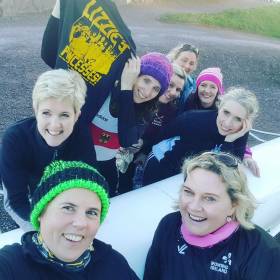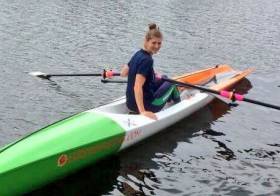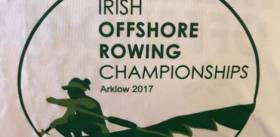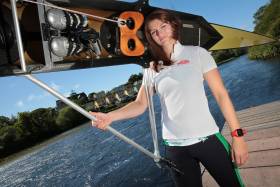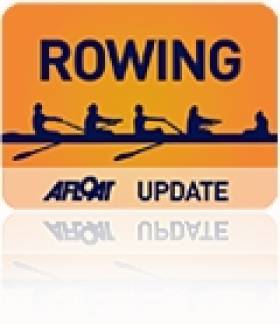Displaying items by tag: Monika Dukarska
Cork and Shandon In Form at Muckross Head
#Rowing: Cork Boat Club’s intermediate eight proved the fastest crew at the Muckross Head of the River at the National Rowing Centre. Shandon, who had a set of good results, saw their eight finish just five seconds off that pace – and their junior 18 quadruple took just nine minutes and 48 seconds to cover the course, placing them seventh overall. Justin Ryan of Skibbereen was the fastest single sculler.
The adult women’s ranks were thinner in numbers. Monika Dukarska was the fastest single sculler. A masters women’s crew from Lady Elizabeth and Dublin University Ladies Boat Club won: it featured well-known names, including former internationals Vanessa Lawrenson and Heather Boyle.
Muckross Head of the River – Selected Results
Overall: 1 Cork BC intermediate eight 9 mins 20 sec, 2 Shandon inter eight 9:25, 3 UCC senior quadruple 9:35.
Men, Eight – Intermediate: Cork 9:20. Club One: UCC 9:35. Club Two: UCC 9:44. Jun 16: Fermoy 10:35. Masters: Castleconnell 13:25.
Four – Sen: Shandon 9:56. Inter, coxed: Skibbereen 10:36. Club One: UCC 10:33. Jun 18, coxed: Presentation Col (D Murphy) 11:07
Pair – Sen: Skibbereen 10:54. Jun 18: Shandon 10:55.
Sculling, Quadruple – Sen: UCC 9:35. Club One, coxed: UCC 13:05. Club Two, coxed: Workmen’s 11:05. Masters, coxed: Clonmel 13:26. Jun 18: Shandon 9:48. Jun 16, coxed: Lee 10:56.
Double – Sen: UCC 11:33. Inter: UCC 10:37. Club One: Shandon 11:09. Jun 18: Skibbereen 11:11. Jun 16: Shandon 11:28.
Single – Sen: Skibbereen (J Ryan) 11:26. Inter: Castleconnell (P Silke) 12:00. Club One: Castleconnell 12:15. Club Two: Cork (R Povey) 12:16. Jun 18: Shandon (E Gaffney) 11:39. Jun 16: Tralee (B Winde) 12:57. Masters (H, adjusted): Lee Valley 13:40 (11:36).
Women,
Eight – Club One: Lee Valley 13:08. Club Two: Shandon 11:12. Jun 16: Muckross 12:28. Masters: Lady Elizabeth, Trinity 12:35.
Four – Sen: Skibbereen 11:36. Inter, coxed: Skibbereen 12:53. Club Two, coxed: Cork 12:22.
Pair – Sen: UCC/Skib 11:58.
Sculling, Quadruple - Sen: Workmen’s 10:50. Club One, coxed: Fermoy 12:14. Club Two, coxed: Lee 12:35. Jun 18: Workmen’s 11:12. Jun 16, coxed: Lee 12:29.
Double – Sen: Cork 11:41. Club One: Workmen’s 12:00. Jun 18: Workmen’s 11:49. Jun 16: Killorglin 12:19.
Single – Sen: Killorglin (M Dukarska) 11:54. Inter: Skibbereen (L Heaphy) 13:09. Club One: Lee Valley 13:08. Club Two: Killorglin (E O’Donovan) 13:35. Jun 18: Kenmare (E Crowley) 13:19. Jun 16: Killorglin (R O’Donoghue) 13:19. Masters: Clonmel (F, adjusted) 14:54 (13:26)
UCD Celebrate 100 Years in Style
#Rowing: The UCD Boat Club centenary dinner was a huge and successful occasion, with 425 attendees. Tom Sullivan (81) was the keynote speaker and gave a summation of the history of the club: not just the good days, such as the 1974 win in the Ladies Plate at Henley Royal Regatta (he was the coach), but also the tough times early on, when one of the mentors, James Meenan, said that “championships were not for the likes of us”.
Sullivan was not the only one who could look back to the middle of the last century and revel in the successes. Michael Cleary (91) rowed in the late 1940s and early 1950s. He received a special award.
Ten other presentations were made to important figures in the history of the club.
UCD Centenary Awards
Liz Cooke, Colm Daly, Johnny Devitt, Martin Feeley, Claire Lambe, David Neale, Murrough O’Brien, Jaye Renehan, Brian Sherry, Tom Sullivan.
Silver for Ireland's Dukarska at World Coastal Rowing
#Rowing: Ireland’s Monika Dukarska took silver at the World Coastal Rowing Championships in Thonon on Lake Geneva in France. The Killorglin woman held second for virtually the entire race behind Diana Dymchenko of Ukraine, who shot into an early lead and held it all the way to the end to take gold. The two fought a battle at the front of the field, but Dukarska could not close the clearwater gap Dymchenko had opened.
Earlier, Castletownbere had finished 14th in the women's coxed quadruple - they were moved up one place in the revised resutls.
World Coastal Rowing Championships, Thonon, France, Day Two (Selected Results; Irish interest)
Men
Solo – A Final: 1 Italy (Padova; S Martini) 28:13.67; 18 Ireland (Arklow; J Casey) 32:12.72; 20 Ireland (Castletownbere; A Sullivan-Greene) 33:14.91; 21 Ireland (Bantry; A Hurley) 34:22.78.
Women
Quadruple, Coxed – A Final (Revised Result): Greece (Nautical Club of Thessaloniki) 27 min 34.98, 2 Italy (CC Saturnia) 27:41.49, 3 Germany (Erster Kieler RC v 1862e V) 27:49.29; 15: Ireland (Castletownbere: E Hanley, C O’Regan, O Gilsenan, M Sheehan; cox: C Connolly) 30:42.58. B Final: 1 Ireland (Galley Flash) 20:46.06, 2 Ireland (Cairndhu) 20:56.34.
Double – B Final: 2 Arklow 21:08.80.
Solo – A Final: 1 Ukraine (Concord; D Dymchenko) 29:58.40, 2 Ireland (Killorglin; M Dukarska) 30:30.78, 3 France (Team Chablais Aviron; E Alfred) 30:54.44; 15 Ireland (Arklow; S Healy) 34:16.49. B Final: 2 Ireland (Killorglin: J Lee) 23:39.30.
Casey and Dukarska Excel at Irish Offshore Championships
#Rowing: The titles at the Irish Offshore Championships were widely spread. Only the host club, Arklow, won twice, through their women’s double and John Casey in the offshore single. Casey, though he rows for Arklow and now lives nearby, is from Sneem. The quadruples went to Courtmacsherry (men) and Castletownbere (women), while New Ross won the men’s double. Killorglin woman Monika Dukarska, who will defend her world title in the offshore single next month in France, was dominant in the boat at Arklow. Conditions were testing, with a strong wind and rain squalls.
Irish Offshore Championships, Arklow (Selected Results; Winners)
Men
Sculling, Quadruple, coxed: Courtmacsherry 18:52.0.
Double: New Ross B 20:14.0.
Single: Arklow (Casey) 21:24.0
Women
Sculling, Quadruple, coxed: Castletownbere 26 min 42 sec.
Double: Arklow 22:27.0
Single: Killorglin (Dukarska) 21:59.0.
Puspure Takes Third in B Final at Lucerne Rowing
#Rowing: Sanita Puspure took third in the B Final of the women’s single sculls at the World Cup Regatta in Lucerne, ninth overall, while Monika Dukarska was three places further back, in sixth (12th overall). Puspure was part of a five-boat sprint finish, and she showed good speed to finish ahead of Fie-Udby Erichsen of Denmark and Ekaterina Karsten of Belarus. Ahead of her was winner Diana Dymchenko of Ukraine and Hannah Osborne of New Zealand. Dukarska, who had started well, had fallen a few lengths off this leading group by the finish.
World Cup Regatta, Lucerne, Day Three (Irish interest)
Women
Single Sculls – B Final: 1 Ukraine 7:39.55, 2 New Zealand 7:41.55, 3 Ireland One (S Puspure) 7:42.23, 4 Denmark One 7:42.26, 5 Belarus 7:42.89, 6 Ireland Two (M Dukarska) 7:56.07.
Puspure So Close to A Final Place in Lucerne World Cup
#Rowing: Ireland’s Sanita Puspure and Monika Dukarska finished fourth and sixth in their semi-final today and will take part in the B Final at the World Cup Regatta in Lucerne. Magdalena Lobnig of Austria, Annekatrin Thiele of Germany and Vicky Thornley of Britain took the qualifying places, in that order, but Puspure was finishing fast and came within a second of overtaking Thornley, who just held on to that vital third place.
World Cup Regatta, Lucerne – Day Two (Irish interest)
Women
Single Sculls Semi-Finals (First Three to A Final; rest to B Final) – Semi Final One: 1 Austria (M Lobnig) 7:35.06, 2 Germany (A Thiele) 7:35.96, 3 Britain (V Thornley) 7:36.09; 4
Ireland One (S Puspure) 7:36.90; 6 Ireland Two (M Dukarska) 7:55.0.
#Rowing: Paul O’Donovan set a new personal best as a single sculler at Cork Regatta today. The Skibbereen sculler won the Division One A Final in six minutes 50.819 seconds. Gary O’Donovan was 13 seconds further back in sunny conditions with a cross-tailwind.
Sanita Puspure pulled out of the women’s single sculls final, but she had already won the heat, beating Monika Dukarska by six seconds. Dukarska won the final.
Mark O’Donovan and Shane O’Driscoll beat Shane Mulvaney and David O’Malley by 3.4 seconds after a good race in the men’s pair.
Cork Regatta, National Rowing Centre, Day One (Selected Results)
Men
Eight – Div Two – A Final: 1 UCD B (club two) 6:22.449, 2 Shandon (jun 16) 6:36.97; 4 Trinity (nov) 6:41.7.
Four – Div One, coxed – A Final: 1 NUIG (inter) 6:22.49; 4 UCD B (sen) 6:28.46; 6 Neptune (jun 18A) 6:38.53.
Pair – Div Two – A Final: 1 Skibbereen (sen) 6:36.43; B Final: 2 Cork (jun 18A) 7:03.17. C Final: 5 Neptune A (club one) 7:16.46.
Sculling,
Quadruple – Div One – A Final: 1 UCC, UCD, Skibbereen (sen) 5:57.88; 2 Three Castles (jun 18A) 6:11.99. B Final: UCC (club one) 6:38.49.
Double – Div Two – A Final: 1 Shandon (jun 18B) 6:57.74; 3 Waterford (club two) 7:04.61; 4 Castleconnell A (jun 16) 7:11.77.
Single – A Final: 1 Skibbereen (P O’Donovan; sen) 6:50.82. B Final: 3 Shandon (D Begley; inter) 7:19.11; 4 Castelconnell (J Quinlan; jun 18A)
Women
Eight – Div Two – A Final: 1 Skibbereen (club two) 6:54.5; 5 Trinity (nov) 7:21.92; 6 St Michael’s (jun 16) 7:26.8.
Four, coxed – Div One – A Final: 1 Cork (sen) 7:22.85, 2 NUIG (club one) 7:27.0; 4 Shannon (inter) 7:36.13.
Pair – Div One – A Final: UCC/UCD (sen) 7:35.97; 5 Trinity B (inter) 7:53.23. B Final: Lee (jun 18A) 8:00.457. C Final: Belfast BC (club one) 8:08.607.
Sculling, Quadruple Div One - A Final: Lee (Jun 18A) 6:50.22
Div Two – A Final: 1 Shandon (club two) 7:28.86, 2 Castleconnell (jun 16) 7:31.09; 5 Shandon (jun 18B) 7:54.69.
Double – Div Two – A Final: 1 Carlow (jun 16) 7:44.19; 5 Graiguenamanagh (jun 18B) 8:17.88; 6 Killorglin (club two) 8:23.69.
Single – Div One – A Final: 1 Killorglin (M Dukarska; sen) 7:40.23; 3 Skibbereen (A Casey; jun 18A) 7:56.17; 4 Skibbereen (O Hayes; lwt) 7:59.73. C Final: 2 Skibbereen (L Heaphy; inter) 8:11.60; 6 Garda (J Ryan; club one) 8:44.57.
Puspure Wins Battle of the Ireland Crews at Poznan
#Rowing: Sanita Puspure won the B Final of the women’s single sculls at the World Cup Regatta in Poznan today. The focus may have been on the battle between Puspure and Monika Dukarska, but Puspure’s main challenger down the course was Megan O’Leary of the United States. She finished a close-up second, with Dukarska third, 3.55 seconds behind her Ireland team-mate.
In the B Final of the women’s pair, the new crew of Aifric Keogh and Aileen Crowley started well but had to give way to the more accomplished United States crew of Kathrin Roach and Sophia Vitas, who took eighth overall.
World Cup Regatta, Poznan, Poland, Day Three (Selected results; Irish interest)
Women
Pair – B Final: 1 United States 7:22.54, 2 Ireland (A Keogh, A Crowley) 7:30.09.
Single Sculls – B Final: 1 Ireland One (S Puspure) 7:28.79, 2 United States Two (M O’Leary) 7:29.35, 3 Ireland Two (M Dukarska) 7:32.34; 4 Germany Two 7:36.36, 5 United States One 7:37.43, 6 Austria Two 7:40.21.
Bronze for Ireland at World University Rowing
#Rowing: Monika Dukarska took a bronze medal for Ireland at the World University Rowing Championships in Poland today. The Ireland single sculler took a third place behind Germany’s Julia Leiding and Lisa Farthofer of Austria, who just beat her in the battle for silver. The Killorglin woman had been in the Ireland high performance programme until earlier this year.
World University Rowing Championships, Poznan, Poland (Selected Results; Irish interest)
Men
Double - B Final: 3 Ireland (P Doyle, T Oliver) 6:42.56.
Lightweight Single - B Final: 6 Ireland (C Beck) 7:36.15.
Women
Four - B Final: 2 Ireland (A Feeley, A Crowley, S Bennett, E Lambe) 7:14.68.
Double Sculls - B Final: 3 Ireland (O Bouanane, O Blundell) 7:44.83.
Lightweight Double Sculls: 3 Ireland (D Synott, J McCarthy) 6:49.87.
Single Sculls - A Final: 1 Germany (J Leiding) 7:33.73, 2 Austria (L Farthofer) 7:35.35, 3 Ireland (M Dukarska) 7:35.99.
Kennedy and Dukarska Take Rowing Gold Again
#ROWING – Ireland's Leonora Kennedy and Monika Dukarska won gold for the second day running at the Memorial Paolo d'Aloja regatta in Piediluco in Italy. The Enniskillen/Killorglin pair have only come together as a crew in recent weeks, but again proved faster than Spain and Italy crews.
The lightweight women's double of Claire Lambe and Denise Walsh competed with the heavyweight crews and finished fifth.
The Ireland men's lightweight double missed out on the final: they raced well on Saturday evening but finished third behind South Africa, the world champions, Greece.
Memorial Paolo d'Aloja Regatta, Piediluco, (A Finals unless stated; Irish interest)
Saturday
Women
Pair: 1 Ireland (L Kennedy, M Dukarska) 7:35.74, 2 Spain 7:37.11, 3 Italy Two 7:38.79.
Lightweight Double Sculls: 1 South Africa 7:11.05, 2 Italy 7:17.41, 3 Ireland (C Lambe, D Walsh) 7:18.97.
Single Sculls: 1 Switzerland (J Gmelin) 7:56.63, 2 Greece Two (A Asoumanaki) 7:57.42, 3 Zimbabwe (M Thornycroft) 7:58.40; 4 Ireland (S Puspure) 8:01.67.
Lightweight Single Sculls: 1 Switzerland (P Merz) 7:46.88, 2 South Africa (K Johnstone) 7:49.80, 3 Switzerland Two (R Frederique) 7:20.25; 4 Ireland (S McCrohan) 7:50.35.
Saturday Heats
Men
Lightweight Double – Heat Three: 1 South Africa 6:24.87, 2 Greece 6:25.40, 3 Ireland (P O'Donovan, G O'Donovan) 6:26.49
Women
Lightweight Single Scull – Heat One: 2 McCrohan 8:17.38.
Sunday – Finals
Women
Pair: 1 Ireland (Kennedy, Dukarska) 7:31.65, 2 Spain 7:32.49, 3 Italy Two 7:35.41.
Double Sculls: 1 Lithuania (D Vistartaite, M Valciukaite) 7:01.59; 5 Ireland (Lambe, Walsh) 7:26.33.



























